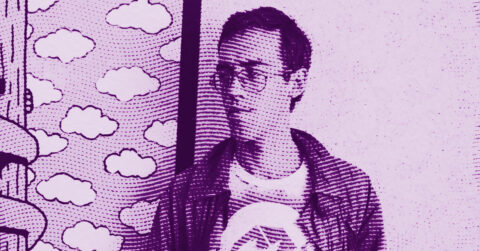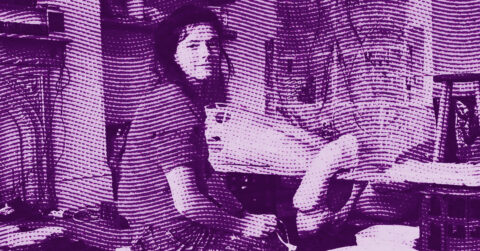Listen to me carefully, you bunch of snobs: Calvin Marcus will never ask your permission to displease you. This California artist, born in San Francisco in 1988, has been building for a decade a body of work that stubbornly refuses any form of intellectual comfort. His paintings of dead soldiers, his self-portraits with a hanging tongue, his oversized sturgeons stretched out on canvases as long as limousines, all of this is part of a deliberate evasion strategy, a systematic refusal to be pinned down in any category. Marcus works in stylistically distinct series, developing new material methodologies for each body that explore disturbing subjects, both psychic and social, through a variety of media. As he himself plainly explains: “I feel no loyalty to any particular medium, I let the idea dictate the form and start from there”[1].
This formal fluidity is not an aesthete’s whim longing for recognition. On the contrary, it reveals a philosophical stance deeply rooted in existentialist thought, that of an artist who claims freedom as a cardinal value of his practice. Asked about his relationship to reason and logic, Marcus responds with disarming frankness: “My relationship to reason is my interest in self-change; acknowledging that freedom is what I really want for myself and my art”[2]. This statement resonates with particular acuity when confronted with the concepts developed by Jean-Paul Sartre in Being and Nothingness. For Sartre, human existence is defined by its radical freedom, by this capacity, and this condemnation, to constantly choose oneself. Sartre’s man is “condemned to be free,” thrown into a world without pre-established essence, forced to define himself by his actions. Marcus seems to have internalized this lesson with remarkable intelligence. By refusing to develop a recognizable “brand,” mutating stylistically from one exhibition to another, he aligns himself with this existentialist tradition which makes freedom not a luxury but an ontological necessity.
Yet, this freedom claimed by Marcus is never light or carefree. It carries the weight of existential anguish, that Sartrean nausea that arises when one becomes aware of one’s own contingency. His series, the dead soldiers of 2016, the smiling ceramic fish, the meticulously rendered grass paintings, function as explorations of extreme situations where the absurd competes with the tragic. The series Were Good Men, presented at Clearing in 2016, offers a particularly striking example of this tension. Across thirty-nine monumental canvases, Marcus deploys figures of soldiers fallen in battle, rendered in a style reminiscent of children’s drawings, with their crude lines and primary colors. These contorted bodies with swollen faces, tinted violet, green, or brown, with bulging eyes and long hanging pink tongues, lie on masses of brightly green grass. The strength of the installation lay in the oversized scale of the canvases and their labyrinthine arrangement, creating an oppressive spatial experience that literally trapped the viewer in a universe of stylized death. These images, paradoxically visually and ethically silent, raise dizzying questions about masculine identity, representation, power, and the drive for self-destruction.
Marcus’s work also finds a troubling echo in the theatre of the absurd, particularly in the world of Samuel Beckett. Like Beckett’s characters, prisoners of incomprehensible and repetitive situations, Marcus’s subjects seem suspended in an indefinite temporality, between presence and absence, between being and nothingness. Take Waiting for Godot, this foundational play of the theatre of the absurd where Vladimir and Estragon wait indefinitely for a Godot who will never come. Waiting, for Beckett, is not aimed at a goal but constitutes the very essence of existence. Similarly, Marcus’s dead soldiers do not tell a story of any particular war; they embody war in general, stripped of all specific political or social context. They are figures awaiting meaning, bodies suspended in a state that rejects both heroic glorification and militant denunciation. This apparent neutrality, far from being a weakness, may perhaps be the subversive strength of these paintings. They confront us with the fundamental absurdity of organized violence without offering us the moral comfort of a clear ideological position.
The parallel with Beckett deepens when examining the serial structure of Marcus’s work. Just as Beckett repeats situations and motifs in a stubborn quest for a kernel of truth that always eludes, Marcus revisits certain themes, the demonic self-portrait, everyday objects magnified or distorted, in variations that do not progress linearly but revolve around an absent center. In Endgame, Beckett stages Hamm, blind and paralyzed, and his servant Clov, in a daily ritual devoid of purpose. The world gradually unravels there, without catastrophe, in an agony that refuses to end. Marcus’s smiling ceramic fish, presented in their different contexts (a plate of spaghetti, an oyster shell), possess that same quality of familiar strangeness, that oscillation between naïveté and threat that characterizes Beckett’s universe. These small self-contained worlds, both fragile and hermetic, seem as private, and as universal, as the teeming depths of Marcus’s imagination.
The question of scale, recurring in Marcus’s work, is particularly interesting. His canvases can reach the length of a limousine to accommodate abnormally long sturgeons; his grass paintings glorify details usually relegated to the background until they become the sole subject of obsessive square compositions. This play on scale is not gratuitous. It functions as a device to activate the exhibition space and disrupt the viewer’s experience. By drastically enlarging certain elements, Marcus forces us to reconsider our relationship with the world of appearances. What seemed trivial, a blade of grass, a miniature fish, suddenly acquires a monumental presence that alters our perception. This strategy recalls the methods of expressionist cinema where spatial distortion served to externalize psychological states. For Marcus, scale becomes a language expressing the uncanny strangeness of reality. The unexpected changes in scale and the strangeness they generate constitute a pronounced theme in his practice, creating visual effects that oscillate between enchantment and grotesque.
It would be tempting to read Marcus’s work solely through the prism of surrealism, a label the artist explicitly rejects: “No, but I understand why someone might think that I am interested in that” [2]. This denial is revealing. Marcus does not seek to access any collective unconscious nor to unleash the forces of dreams. His approach is more down-to-earth and, paradoxically, more unsettling. He works in the deadpan register, that neutral and impassive tone that refuses emphasis while delivering deeply disturbing content. His paintings “appear deceptively familiar at first glance, whether because of their subject, the scene, or the offered absurdity, but with even the slightest engagement, the meaning often grows until ambiguity itself seems monstrous” [3]. This ability to reveal the dark side of an object, to evoke through intense magnification a real or imagined terror, or a latent unease, is one of Marcus’s distinctive talents.
Let’s return briefly to this notion of freedom that seems to haunt Marcus’s work. In a contemporary artistic climate where “there is a desire to develop something that almost has an iconic brand status,” Marcus asserts the right to evasion, fluidity, and perpetual change [4]. This position echoes Sartre’s critique of “bad faith,” that human tendency to freeze into predefined roles to escape the anxiety of freedom. The artist who develops a recognizable “signature” condemns himself to repetition, locking himself in an essence that precedes and limits his existence. Marcus fiercely refuses this ease. His exhibitions, described as “tightly constructed panoramas” and “labyrinthine presentations,” amplify the unsettling effect of his works while creating immersive experiences that trap and disorient the viewer. This staging is never trivial: it participates in the same will to disrupt, the same distrust of perceptual comfort.
The trajectory of Marcus, from his first exhibitions at Public Fiction and Peep-Hole to his participation in the 2019 Whitney Biennial and his recent institutional exhibitions at the Museum Dhondt-Dhaenens in Belgium, reveals a meteoric rise in the contemporary art world. His works are now part of the permanent collections of the Museum of Modern Art in New York, the Musée d’Art Moderne in Paris, the Los Angeles County Museum of Art, among other major institutions. This institutional recognition might seem contradictory to the artist’s anti-establishment stance. But Marcus has understood that one can play the game without being fooled, accept the rules of the art market without renouncing his creative freedom. His approach recalls that of Philip Guston, one of his major influences, who abandoned abstract expressionism at the height of his fame to return to a disturbing cartoonish figuration. Guston, like Francis Bacon and Paul Thek, the other references cited by Marcus, rejected complacency and did not hesitate to betray the expectations of his audience to remain faithful to his own inner necessity.
Marcus’s future remains deliberately unpredictable. This is what makes his work so stimulating. In an art world often trapped by its own codes, where recognition comes from the immediate identification of a style, Marcus offers a rare alternative: that of an artist who constantly reinvents himself, who accepts the risk of displeasing and puzzling in order to preserve his freedom. His works do not seek to please nor to shock for the mere pleasure of provocation. They pose uncomfortable questions about identity, representation, violence, masculinity, without ever imposing definitive answers. They confront us with the fundamental absurdity of existence while rejecting nihilistic cynicism. In this, they fully belong to the existentialist tradition which recognizes the absurd not as a paralyzing fate but as the starting point of authentic freedom.
Marcus’s practice reminds us that art, at its best, is not a product of cultural consumption but an experience that destabilizes us and forces us to reconsider our certainties. His dead soldiers do not glorify war but neither do they condemn it simplistically; his demonic self-portraits reveal no transparent psychological truth; his meticulous paintings of grass do not naively celebrate nature. Everything in his work resists univocal interpretation, maintains a productive tension between contradictory meanings. This ambiguity is not a weakness but the mark of an artistic intelligence that understands that the contemporary world cannot be grasped by simple formulas. Faced with the complexity of reality, Marcus chooses the multiplication of approaches, endless exploration, the refusal to become fixed. He invites us to do the same: to accept uncertainty, to embrace freedom in its most vertiginous form. It is a risky, uncomfortable, often baffling bet. It is also what makes his work one of the most stimulating artistic adventures of his generation. The work of Calvin Marcus thus constitutes an unstable territory where beauty brushes with unease, where humor flirts with horror, where every certainty is immediately contradicted. It is precisely in this instability that his strength lies: it forces us to stay awake, vigilant, incapable of resting on comfortable perceptual habits. It makes us, viewers, involuntary accomplices of a quest that will never end, of a freedom that will never rest.
- Official Karma website, biography of Calvin Marcus.
- Flaunt Magazine, interview with Ben Noam, “Calvin Marcus: Home is where the undulating, wise, and aquarist scale is”.
- David Kordansky Gallery, text for Frieze Seoul 2022.
- Louisiana Channel, “Calvin Marcus: I Want to Be Far from Polite”, June 2022.
















